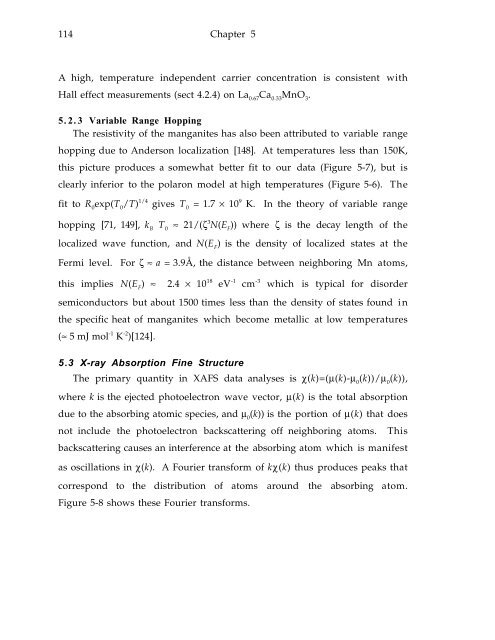MAGNETISM ELECTRON TRANSPORT MAGNETORESISTIVE LANTHANUM CALCIUM MANGANITE
MAGNETISM ELECTRON TRANSPORT MAGNETORESISTIVE LANTHANUM CALCIUM MANGANITE
MAGNETISM ELECTRON TRANSPORT MAGNETORESISTIVE LANTHANUM CALCIUM MANGANITE
You also want an ePaper? Increase the reach of your titles
YUMPU automatically turns print PDFs into web optimized ePapers that Google loves.
114 Chapter 5<br />
A high, temperature independent carrier concentration is consistent with<br />
Hall effect measurements (sect 4.2.4) on La 0.67 Ca 0.33 MnO 3 .<br />
5. 2. 3 Variable Range Hopping<br />
The resistivity of the manganites has also been attributed to variable range<br />
hopping due to Anderson localization [148]. At temperatures less than 150K,<br />
this picture produces a somewhat better fit to our data (Figure 5-7), but is<br />
clearly inferior to the polaron model at high temperatures (Figure 5-6). The<br />
fit to R 0 exp(T 0 /T) 1/4 gives T 0 = 1.7 × 10 9 K. In the theory of variable range<br />
hopping [71, 149], k B T 0 ≈ 21/(ζ 3 N(E F )) where ζ is the decay length of the<br />
localized wave function, and N(E F ) is the density of localized states at the<br />
Fermi level. For ζ ≈ a = 3.9Å, the distance between neighboring Mn atoms,<br />
this implies N(E F ) ≈ 2.4 × 10 18 eV -1 cm -3 which is typical for disorder<br />
semiconductors but about 1500 times less than the density of states found in<br />
the specific heat of manganites which become metallic at low temperatures<br />
(≈ 5 mJ mol -1 K -2 )[124].<br />
5.3 X-ray Absorption Fine Structure<br />
The primary quantity in XAFS data analyses is χ(k)=(µ(k)-µ 0 (k))/µ 0 (k)),<br />
where k is the ejected photoelectron wave vector, µ(k) is the total absorption<br />
due to the absorbing atomic species, and µ 0 (k)) is the portion of µ(k) that does<br />
not include the photoelectron backscattering off neighboring atoms. This<br />
backscattering causes an interference at the absorbing atom which is manifest<br />
as oscillations in χ(k). A Fourier transform of kχ(k) thus produces peaks that<br />
correspond to the distribution of atoms around the absorbing atom.<br />
Figure 5-8 shows these Fourier transforms.
















